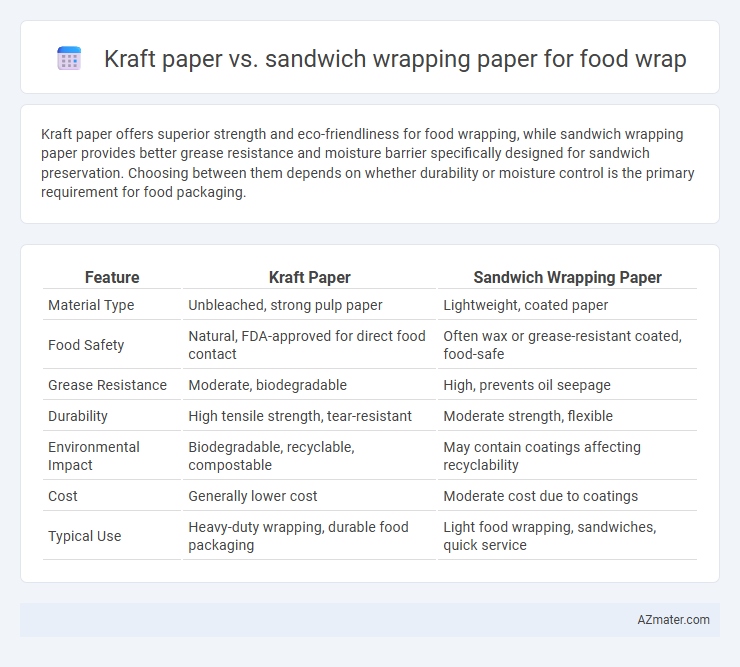Kraft paper offers superior strength and eco-friendliness for food wrapping, while sandwich wrapping paper provides better grease resistance and moisture barrier specifically designed for sandwich preservation. Choosing between them depends on whether durability or moisture control is the primary requirement for food packaging.
Table of Comparison
| Feature | Kraft Paper | Sandwich Wrapping Paper |
|---|---|---|
| Material Type | Unbleached, strong pulp paper | Lightweight, coated paper |
| Food Safety | Natural, FDA-approved for direct food contact | Often wax or grease-resistant coated, food-safe |
| Grease Resistance | Moderate, biodegradable | High, prevents oil seepage |
| Durability | High tensile strength, tear-resistant | Moderate strength, flexible |
| Environmental Impact | Biodegradable, recyclable, compostable | May contain coatings affecting recyclability |
| Cost | Generally lower cost | Moderate cost due to coatings |
| Typical Use | Heavy-duty wrapping, durable food packaging | Light food wrapping, sandwiches, quick service |
Introduction to Food Wrapping Papers
Food wrapping papers such as Kraft paper and sandwich wrapping paper are essential for preserving food freshness and preventing contamination. Kraft paper is strong, biodegradable, and ideal for wrapping heavy or greasy foods, while sandwich wrapping paper is typically waxed or coated for moisture resistance and designed specifically for lighter, ready-to-eat items. Both types ensure hygienic food transport and storage, meeting food safety standards in various culinary environments.
What is Kraft Paper?
Kraft paper is a strong, durable paper produced from chemical pulp in the kraft process, known for its high tear resistance and natural brown color. Used widely in food wrapping, it offers excellent grease resistance and breathability, making it ideal for sandwich wraps that require moisture control to maintain freshness. Compared to typical sandwich wrapping paper, kraft paper provides eco-friendly, compostable packaging options that help reduce plastic waste while preserving food quality.
What is Sandwich Wrapping Paper?
Sandwich wrapping paper is a specialized type of food wrap designed to preserve freshness and prevent moisture buildup in sandwiches. Often coated with a thin layer of wax or polyethylene, it provides a moisture-resistant barrier that helps maintain food quality without compromising breathability. Unlike kraft paper, which is sturdier and typically uncoated, sandwich wrapping paper is optimized for direct contact with food and easy folding, making it ideal for deli and fast-food packaging.
Material Composition
Kraft paper is made from unbleached wood pulp, providing high strength and durability due to its natural fibers, making it ideal for heavy-duty food wrapping. Sandwich wrapping paper is typically composed of lightweight, coated paper or greaseproof paper infused with a thin layer of wax or polyethylene, preventing grease and moisture from seeping through. The material composition determines the suitability of kraft paper for robust packaging and sandwich wrapping paper for moisture resistance and food safety.
Food Safety and Hygiene
Kraft paper, often unbleached and natural, provides a strong barrier with minimal chemical treatments, making it a safer choice for food wrapping by reducing contamination risks. Sandwich wrapping paper is typically coated with wax or polyethylene, creating a moisture-resistant layer that helps maintain food freshness and prevent bacteria growth, enhancing hygiene. Both materials meet food safety standards, but choosing the appropriate type depends on the specific food's moisture content and storage requirements to ensure optimal hygiene.
Grease and Moisture Resistance
Kraft paper provides moderate grease resistance due to its dense fiber structure, making it suitable for dry or lightly oily foods but less effective against heavy grease penetration. Sandwich wrapping paper typically incorporates a polyethylene or wax coating, enhancing its moisture resistance and preventing grease from seeping through, ideal for greasy or moist food items. Choosing sandwich wrapping paper over kraft paper ensures better protection against grease stains and moisture damage in food wrapping applications.
Environmental Impact and Sustainability
Kraft paper is widely favored for food wrapping due to its biodegradable nature and ability to be sourced from sustainably managed forests, reducing environmental footprint. Sandwich wrapping paper often contains coatings or additives like polyethylene, which complicate recycling and contribute to plastic pollution. Choosing uncoated Kraft paper supports compostability and lowers waste generation, aligning with eco-friendly packaging practices.
Cost and Availability
Kraft paper offers a cost-effective and widely available option for food wrapping, with its durable, biodegradable properties making it suitable for various packaging needs. Sandwich wrapping paper is often more specialized, sometimes coated for grease resistance, and may come at a higher price point with varied availability depending on suppliers. Choosing between Kraft and sandwich wrapping paper hinges on balancing budget constraints with specific functional requirements like moisture resistance and local supply access.
Best Uses: Kraft Paper vs Sandwich Wrapping Paper
Kraft paper is best suited for wrapping heavier or bulkier food items, offering durability and resistance to tearing, making it ideal for greasy or moist foods. Sandwich wrapping paper is designed specifically for wrapping sandwiches and lighter food items, providing a moisture-resistant barrier that keeps food fresh and maintains its shape without absorbing oils. For greasy or heavier foods, choose kraft paper, while sandwich wrapping paper is optimal for lighter, drier food items requiring freshness and easy handling.
Conclusion: Which Food Wrap is Better?
Kraft paper offers superior durability and grease resistance, making it ideal for robust food items that need extra protection, while sandwich wrapping paper excels in flexibility and is often coated for moisture resistance, enhancing freshness for lighter, moisture-prone foods. Choosing between them depends on the specific food type and packaging requirements; kraft paper is better suited for heavy or oily foods, whereas sandwich wrapping paper is preferred for maintaining the texture and moisture balance of sandwiches and delicate items. For optimal performance, understanding the food's moisture and grease levels will guide the best choice between kraft and sandwich wrapping paper.

Infographic: Kraft paper vs Sandwich wrapping paper for Food wrap
 azmater.com
azmater.com